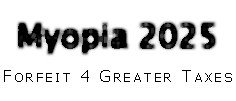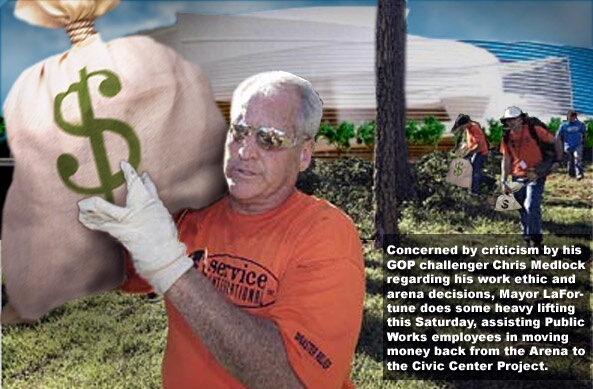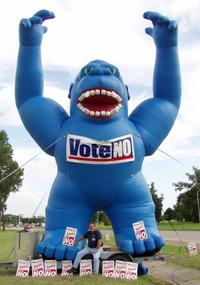NOTE: I originally published this as a special page on this site, rather than as a blog entry. To make it easier to find, on July 11, 2007, I've added it as an entry on the blog.
Why Vote No?
Against the proposed Tulsa County Sales Taxes
September 9, 2003
(alias Vision 2025)
Proposition 1: Boeing
Proposition 2: American Airlines
Proposition 3: Arena, higher ed, etc.
Proposition 4: Parks, tourist attractions, etc.
Links to other batesline.com entries
On September 9, Tulsa County residents will vote on four new sales taxes, totaling 1% for 13 years. We believe this is the wrong tax, at the wrong time, for the wrong projects.
Adding these new taxes at this time will hurt an already-suffering local economy. These new taxes increase the cost of basic necessities (food, clothing, electricity, natural gas, over-the-counter medicines), a cruel additional burden to impose on the thousands of Tulsans who are unemployed and underemployed. Tulsa's sales tax rate will become the 4th highest of the 50 largest cities in America. The tax rate in other Tulsa County cities will approach 10%. At a time when federal officials are cutting taxes to stimulate the economy, raising local taxes will undo their efforts locally.
Even if times were good, none of these projects are urgent enough to justify a tax increase. Many of these projects shouldn't be funded by sales tax at all, because they aren't sound public investments. Some of the projects are worthwhile, but they can be funded when we renew existing revenue sources like Tulsa's "third penny" sales tax. Government should live within its means instead of asking us to tighten our belts.
The proposed projects do not address our region's most urgent needs. None of the money will be used to fix the city's budget problems. None of the money will address the heart of our unemployment problem -- the loss of thousands of high-tech jobs. Laid-off computer engineers from WorldCom and other companies won't qualify for jobs as Boeing factory workers.
This package is not visionary, and it does not lay a foundation for future economic vitality or improved quality of life. It consists of corporate welfare, a twice-rejected downtown arena, and a piece of the pie for each of the suburbs. The Dialog/Visioning leadership team, a body dominated by the Chamber of Commerce and construction, hotel, and real-estate interests, did not address crucial questions about transportation, growth, demographic trends, and economic diversification.
There are also serious concerns about how the tax receipts will be managed and overseen. The tax will continue for 13 years, with no limit on the money it could raise -- a conservative estimate is $1.2 billion, over $2,000 for every Tulsa County resident. County government in Oklahoma lacks checks and balances. The county public trust can add and delete projects and spend excess funds without a vote of the people. That's why we refer to this as a billion-dollar blank check. The funding plan involves borrowing nearly all the money up front and paying it back over 13 years -- an approach that could cost taxpayers $200 million in interest.
No plan is perfect. And we have to do something, don't we?
Tulsa has lost a lot of jobs -- 27,000 over a two-year period. All the more reason that we shouldn't just do something. We need to do something effective. When I'm sick, I don't just want a doctor to do something, and I don't just want him to deal with symptoms. I want him to apply his diagnostic skills to identify and address the root problem. This package doesn't fix Tulsa's "symptoms" -- our current recession -- nor does it lay a foundation for sustainable economic development and future prosperity.
Tulsa County residents have invested well over a billion dollars for capital improvements over the last 10 years -- money for education and quality of life, as well as basic infrastructure -- public schools, higher education, downtown improvements, museums, convention and performing arts facilities, parks. We should be proud of what we've accomplished, and we should expect our government leaders to make better use of the tax dollars they already get from us.
Where can I learn more?
On the web, go to www.batesline.com for extended commentary on this sales tax proposal and the vision process. If you have further questions, e-mail Michael Bates at blog at batesline dot com.
A sample ballot and the official ballot resolutions are online at www.tulsacounty.org
Why vote NO on Proposition 1 (0.4% for Boeing)?
This proposition invests your tax dollars in a troubled company in a troubled industry. It puts all our eggs in one basket. Tulsa's economy is already too dependent on commercial aviation, which is in a slump from which it will not soon emerge. It does nothing to address the need for high-tech jobs, which make up the bulk of the jobs we've lost over the last two years. It is a shortsighted approach to economic development: We can't afford to buy all the jobs we need at the rate of $350,000 per job. Instead we need to make Tulsa a better environment to start and grow businesses. And because of a loophole in the ballot, the full amount of the tax could be imposed (over $400 million) even if just a handful of 7E7-related jobs are located here. Oklahoma already offers incentives to companies that create new jobs in our state.
Relevant articles on batesline.com
All our eggs in the aerospace basket
Boeing to cut 4000 airplane jobs
High-tech underemployment
Dilbert on corporate welfare
Is Tulsa's port deep enough?
Nordam adds jobs -- cost to taxpayers = $0
Regain technology jobs? "I have no idea"
North Carolina built it -- and no one came
Boeing puts squeeze on states in search of corporate welfare
Business Reform looks at Tulsa's corporate welfare bid
External sites
Seattle Times -- 7E7 story archive
Why vote NO on Proposition 2
(0.025% for American Airlines)?
American Airlines' long-time and significant presence in Tulsa is worthy of our appreciation, and the City of Tulsa has already demonstrated appreciation by approving $8 million in assistance earlier this summer, in the form of capital improvements and rate cuts that will help other industries as well. American Airlines is already eligible for millions in state incentives if they add jobs here. AA hasn't threatened to leave if we don't vote to pay them this extra $22.3 million, nor have they promised to add jobs or rollback concessions if we do.
Simply giving money to a specific company is unfair to the many other companies who stay here and create new jobs here. Many AA employees feel they've already paid enough for the mistakes of management, through drastic wage and benefit concessions. AA workers look at wasteful corporate spending on executive bonuses and sports arena naming rights (over $200 million for arenas in Miami and Dallas) and ask why they should pay higher taxes to give their bosses more money to throw away.
Relevant articles on batesline.com
A hopeful sign
Kansas City's risky offer to AA
What we've already done for American Airlines
Why vote NO on Proposition 3
(0.4% for arenas / convention center / education / Morton Healthcare center)?
Most of this money ($183 million) will be spent on a new 20,000-seat downtown sports arena and downtown convention center expansion, facilities that have already been rejected twice by the voters. Feasibility studies show that these facilities will not attract many big-name concerts or major conventions, and instead will cost the city millions of dollars each year to operate and maintain. That reduces the amount of money the City has for funding police and fire protection, street maintenance, and other necessities. The facilities would put government in competition with local private businesses for entertainment and convention dollars.
The education projects were added to this package in a cynical attempt to get the twice-rejected arena passed. In order to get $8 million for a new TCC facility, you have to vote for over $400 million in new taxes -- that's like having to pay for a big-screen TV just to buy a gallon of milk. Tulsa County voters should say no to this package and tell the County Commissioners to try it again, the right way: Give us a chance to vote for higher education facilities alone.
In the meantime, Tulsa's leaders should push state government to give Tulsa County our fair share of money for higher education facilities. Stillwater and Norman don't have to raise their own taxes for facilities at OSU and OU. Tulsa County residents have already paid millions for campuses and facilities -- we shouldn't have to pay more.
The amount of common education money in this package amounts to $8 per pupil per year -- not enough to buy a ticket to a hockey game at the downtown arena.
Relevant articles on batesline.com
Private enterprise and major entertainment venues
Bricktown's Magic
A millstone by any other name would sink as fast
A collection of Convention Center criticism
Has the secret agenda been revealed?
Tired old thinking is hard to shake
How to improve the convention center without building a new arena
Whirled-class whiners
Convention cutbacks
Not partisanship but principle
Stealth sports arena
Is a new sports arena a need or a desire?
Public hearing intentionally omitted?
Vote yes strategem #1: Tell them something bad about Tulsa
That exciting Oklahoma City arena
No exciting concerts and no big conventions in OKC
If we fix up our convention center, they still won't come
The cargo cult approach to economic development
Why vote NO on Proposition 4
(0.175% for roads, community centers, parks, tourist attractions)?
This proposition includes many worthwhile projects, but none of them are urgent enough to justify a tax increase. On September 9th, we won't be voting on whether we like these projects. We'll be voting on whether we want to raise taxes now because we need them right now. These are the same sort of projects we've funded in the past through temporary sales taxes and bond issues. These projects should be considered as part of the long-term capital improvements process, and included as appropriate in the City of Tulsa's bond issue next year, or in the renewal of sales taxes like "4 to Fix the County" and the City of Tulsa "third penny" in 2006. If any of these projects are truly urgent, our city and county leaders should rearrange current spending priorities to accommodate them.
Relevant articles on batesline.com
The station you used to listen to for news
No federal money for river
Route 66 -- what's in the plan?
Links to other batesline.com articles
About real vision:
My "no" vote is pro-Tulsa
What Tulsa should be doing: Developing venture capital
Will Tulsa's next big idea come from a committee?
Most important considerations in planning Tulsa's future
Opportunity Cost: The Danger of Doing Something Rather Than Nothing
A billion dollars but nothing to fix I-44
Terry Simonson on the economic recovery and the sales tax
Kevin Adams: The Tulsa Time Blues
Wanted: Visionaries -- not a vision
"Vision 2025" isn't forward thinking
TulsaNow speaks on the sales tax election
About economic development:
CITGO going, gone?
Buy local: Hire Tulsa's top talent
MAPS no vaccine against slump
Tulsans have invested billions
Small business drives our economy
What would Joel do?
About taxes and governance:
The Stacked Deck
Vote yes myth: County commissioners cancelled Whirlpool tax early
Jim Hewgley discusses the fiscal case: Why Vision 2025 is myopic
The low-income apartment mess: A reason not to trust Tulsa County government
The impact of high sales taxes -- a local case study
Mayor, Chamber of Commerce to lead sales tax opposition
About downtown:
Wi-Fi as a tool for downtown redevelopment
The view from a seven-year downtown resident
Comments about Atlanta's downtown failures and Tulsa's proposed arena
How NOT to revitalize downtown -- learning from Atlanta
Envisioning Elgin as the new Main Street
Where's the music in downtown?
Whirled needs correction about Solow's views on the mall
About the ballot's constitutionality:
Is the ballot constitutional?
Lawsuit details
About the campaign, debates:
A straw man is easy to knock down
Truth in Whirled headlines
Young Republicans debate; Whirled gets it wrong (again)
Tulsa Now forum
Debate dodging
Whom do you trust?
Arm-twisting?
Whirled in overdrive
$877 million "Vision" plan unveiled
Will the vision process be derailed?

"Vision 2025" broadcast debates
Tuesday, September 2, 12:30 pm,
KRMG (AM 740)
Thursday, September 4, 8 pm,
KOKI (Cable 5, UHF 23)
Replays of the August 29th KWHB debate:
Monday, September 1, 7 pm,
KWHB (Cable 7, UHF 47)
Tuesday, September 2, 7 pm,
KTUL (Channel 8)
Thursday, September 4, 8 pm,
KWHB (Cable 7, UHF 47)
Monday, September 8, 7:30 pm,
KWHB (Cable 7, UHF 47)
Oppose the
billion-dollar blank check!
No new taxes!
To stop the sales tax increases, your help is vital!
To donate, mail a check to:
Tulsa County Coalition / Jim Hewgley
3130 S Quaker Rd
Tulsa OK 74105
For a sign or to volunteer, e-mail voteno2025@usa.com
or call 836-0142



